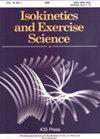Correlation between palpatory assessment and pressure sensors in response to postural trunk tests
IF 0.7
4区 医学
Q4 ENGINEERING, BIOMEDICAL
引用次数: 4
Abstract
BACKGROUND: The evaluation of postural trunk muscle function is a critical component of clinical assessment in patients with musculoskeletal pain and dysfunction. Postural activation of the trunk muscles has been evaluated by various methods. This study evaluates the correlation between subjective assessment of postural trunk muscle function with an objective measurement of abdominal wall expansion. METHODS: Twenty-five healthy participants (16 women, 9 men, age 22.4 years) were assessed. The subjective assessment was performed by two experienced Dynamic Neuromuscular Stabilization (DNS) clinicians evaluating the quality of trunk stabilization using five postural stability tests through palpation and observation. Interrater reliability was determined using an intraclass correlation coefficients (ICC). Objective measurement was performed using a new device (DNS Brace) which externally measures abdominal wall pressure. Spearman rank correlations were calculated for both palpation and observation measures with DNS Brace data. RESULTS: The interrater reliability (ICC2,k) estimates demonstrated moderate reliability in palpation measures for three DNS tests: Hip flexion test, Diaphragm test, & Intra-abdominal pressure regulation test (IAPRT) (ICC = 0.645–0.707). For observation measures, good reliability was found in IAPRT (ICC = 0.835), and three tests demonstrated moderate reliability: Hip flexion test, Diaphragm test, & Breathing Stereotype (ICC = 0.577–0.695). Correlation analysis demonstrated several moderate to strong correlations between palpation and DNS brace values (Assessor 1): IAPRT, rs= 0.580, p= 0.002, Diaphragm test, rs= 0.543, p= 0.005, (Assessor 2): IAPRT, rs= 0.776, p< 0.001, Breathing Stereotype, rs= 0.625, p= 0.001, Diaphragm test, rs= 0.519, p= 0.008, Hip Flexion test, rs= 0.536, p= 0.006, and Arm Elevation test, rs= 0.460, p= 0.021. For observation, several moderate correlations were demonstrated with DNS brace values (Assessor 1): Arm Elevation test, rs= 0.472, p= 0.017, (Assessor 2) Diaphragm test, rs= 0.540, p= 0.005, IAPRT rs= 0.475, p= 0.016, Hip Flexion test, rs= 0.485, p= 0.014, and Arm Elevation, rs= 0.451, p= 0.024. CONCLUSION: Based on inter-rater reliability and DNS brace correlations with trained DNS professionals, the IAPRT, Diaphragm test, and Hip Flexion test may prove useful when assessing asymptomatic individuals. More research is needed in order to establish the utility of DNS brace and clinical testing both in asymptomatic and back pain populations. DNS tests must be supplemented by further examinations for definitive clinical decision making.触诊评估和压力传感器对体位躯干测试反应的相关性
背景:对肌肉骨骼疼痛和功能障碍患者进行体位性躯干肌肉功能评估是临床评估的关键组成部分。躯干肌肉的姿势激活已经通过各种方法进行了评估。本研究评估了体位性躯干肌肉功能的主观评估与腹壁扩张的客观测量之间的相关性。方法:对25名健康参与者(16名女性,9名男性,年龄22.4岁)进行评估。主观评估由两名经验丰富的动态神经肌肉稳定(DNS)临床医生通过触诊和观察,使用五种姿势稳定性测试来评估躯干稳定的质量。使用组内相关系数(ICC)确定询问者的可靠性。使用一种外部测量腹壁压力的新设备(DNS Brace)进行客观测量。根据DNS Brace数据计算触诊和观察测量的Spearman秩相关性。结果:三项DNS测试的患者间可靠性(ICC2,k)估计值在触诊测量中显示出中等可靠性:髋关节屈曲测试、膈肌测试和腹内压力调节测试(IART)(ICC=0.645–0.707)。在观察测量中,IART具有良好的可靠性(ICC=0.835),三项测试显示出中等的可靠性:髋屈曲测试,膈肌测试和呼吸刻板印象(ICC=0.577–0.695)。相关分析表明触诊和DNS支架值之间存在一些中等到强烈的相关性(评估员1):IART,rs=0.580,p=0.002,膈肌测试,rs=0.52 43,p=0.005,(评估员2):IAPT,rs=0.776,p<0.001,呼吸刻板印象,rs=0.625,p=0.001,膈肌试验,rs=0.5 19,p=0.008,髋关节屈曲测试,rs=0.536,p=0.006,手臂抬高试验,rs=0.460,p=0.021。为了观察,DNS支架值(评估员1)显示了几种中等相关性:手臂抬高测试,rs=0.472,p=0.017,(评估员2)膈肌测试,rs=0.540,p=0.005,IAPRT rs=0.475,p=0.01 6,髋关节屈曲测试,r=0.485,p=0.01%4,手臂抬高,rs=0.45 1,p=0.024。结论:基于评分者之间的可靠性和与受过训练的DNS专业人员的DNS支架相关性,IART、膈肌测试和髋关节屈曲测试可能在评估无症状个体时有用。需要更多的研究来确定DNS支架和临床测试在无症状和背痛人群中的实用性。DNS测试必须辅以进一步的检查,以做出最终的临床决策。
本文章由计算机程序翻译,如有差异,请以英文原文为准。
求助全文
约1分钟内获得全文
求助全文
来源期刊

Isokinetics and Exercise Science
医学-工程:生物医学
CiteScore
1.20
自引率
14.30%
发文量
37
审稿时长
>12 weeks
期刊介绍:
Isokinetics and Exercise Science (IES) is an international journal devoted to the study of theoretical and applied aspects of human muscle performance. Since isokinetic dynamometry constitutes the major tool in this area, the journal takes a particular interest in exploring the considerable potential of this technology.
IES publishes studies associated with the methodology of muscle performance especially with respect to the issues of reproducibility and validity of testing, description of normal and pathological mechanical parameters which are derivable from muscle testing, applications in basic research topics such as motor learning paradigms and electromyography. The journal also publishes studies on applications in clinical settings and technical aspects of the various measurement systems employed in human muscle performance research.
The journal welcomes submissions in the form of research papers, reviews, case studies and technical reports from professionals in the fields of sports medicine, orthopaedic and neurological rehabilitation and exercise physiology.
 求助内容:
求助内容: 应助结果提醒方式:
应助结果提醒方式:


